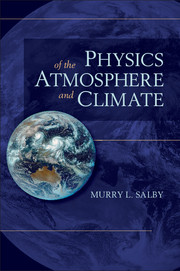Book contents
- Frontmatter
- Contents
- Preface
- Prelude
- 1 The Earth-atmosphere system
- 2 Thermodynamics of gases
- 3 The Second Law and its implications
- 4 Heterogeneous systems
- 5 Transformations of moist air
- 6 Hydrostatic equilibrium
- 7 Static stability
- 8 Radiative transfer
- 9 Aerosol and cloud
- 10 Atmospheric motion
- 11 Atmospheric equations of motion
- 12 Large-scale motion
- 13 The planetary boundary layer
- 14 Wave propagation
- 15 The general circulation
- 16 Dynamic stability
- 17 Influence of the ocean
- 18 Interaction with the stratosphere
- Appendix A Conversion to SI units
- Appendix B Thermodynamic properties of air and water
- Appendix C Physical constants
- Appendix D Vector identities
- Appendix E Curvilinear coordinates
- Appendix F Pseudo-adiabatic chart
- Appendix G Acronyms
- Answers to selected problems
- References
- Index
- Plate section
18 - Interaction with the stratosphere
Published online by Cambridge University Press: 05 June 2012
- Frontmatter
- Contents
- Preface
- Prelude
- 1 The Earth-atmosphere system
- 2 Thermodynamics of gases
- 3 The Second Law and its implications
- 4 Heterogeneous systems
- 5 Transformations of moist air
- 6 Hydrostatic equilibrium
- 7 Static stability
- 8 Radiative transfer
- 9 Aerosol and cloud
- 10 Atmospheric motion
- 11 Atmospheric equations of motion
- 12 Large-scale motion
- 13 The planetary boundary layer
- 14 Wave propagation
- 15 The general circulation
- 16 Dynamic stability
- 17 Influence of the ocean
- 18 Interaction with the stratosphere
- Appendix A Conversion to SI units
- Appendix B Thermodynamic properties of air and water
- Appendix C Physical constants
- Appendix D Vector identities
- Appendix E Curvilinear coordinates
- Appendix F Pseudo-adiabatic chart
- Appendix G Acronyms
- Answers to selected problems
- References
- Index
- Plate section
Summary
Above the tropopause, the horizontal gradient of heating is generally weak enough to leave thermal structure close to barotropic stratification. For this reason, baroclinic instability generated through conversion of available potential energy does not play an essential role. Further, strong westerlies in the winter stratosphere and easterlies in the summer stratosphere trap baroclinic disturbances in the troposphere. Their presence in the stratosphere is therefore limited to a neighborhood of the tropopause. These features leave the circulation in the stratosphere less disturbed than in the troposphere (Fig. 1.10). Exceptions are planetary waves. Unlike baroclinic disturbances, they propagate through strong westerlies of the polar-night jet (Sec. 14.5.2). Vertical amplification enables planetary waves to disturb the polar vortex. During major amplifications, they completely disrupt the circumpolar flow. Air then moves freely between tropical and polar regions, experiencing sharply different radiative environments. Global-scale disturbances such as the one in Fig. 1.10a play a key role in establishing mean distributions of radiatively active constituents.
With convection inhibited by strong static stability, the energy budget of the stratosphere is dominated by radiative transfer. It therefore remains closer to radiative equilibrium than the troposphere (Fig. 8.24). The radiative energy budget is controlled by SW heating due to ozone absorption, principally in the Hartley and Huggins bands (Sec. 8.3.1), and LW cooling due to CO2 emission to space at 15 µm. Ozone, in concert with CO2, thus shapes the thermal structure of the middle atmosphere. Through hydrostatic and geostrophic equilibrium, the latter controls the circulation.
- Type
- Chapter
- Information
- Physics of the Atmosphere and Climate , pp. 566 - 616Publisher: Cambridge University PressPrint publication year: 2012



